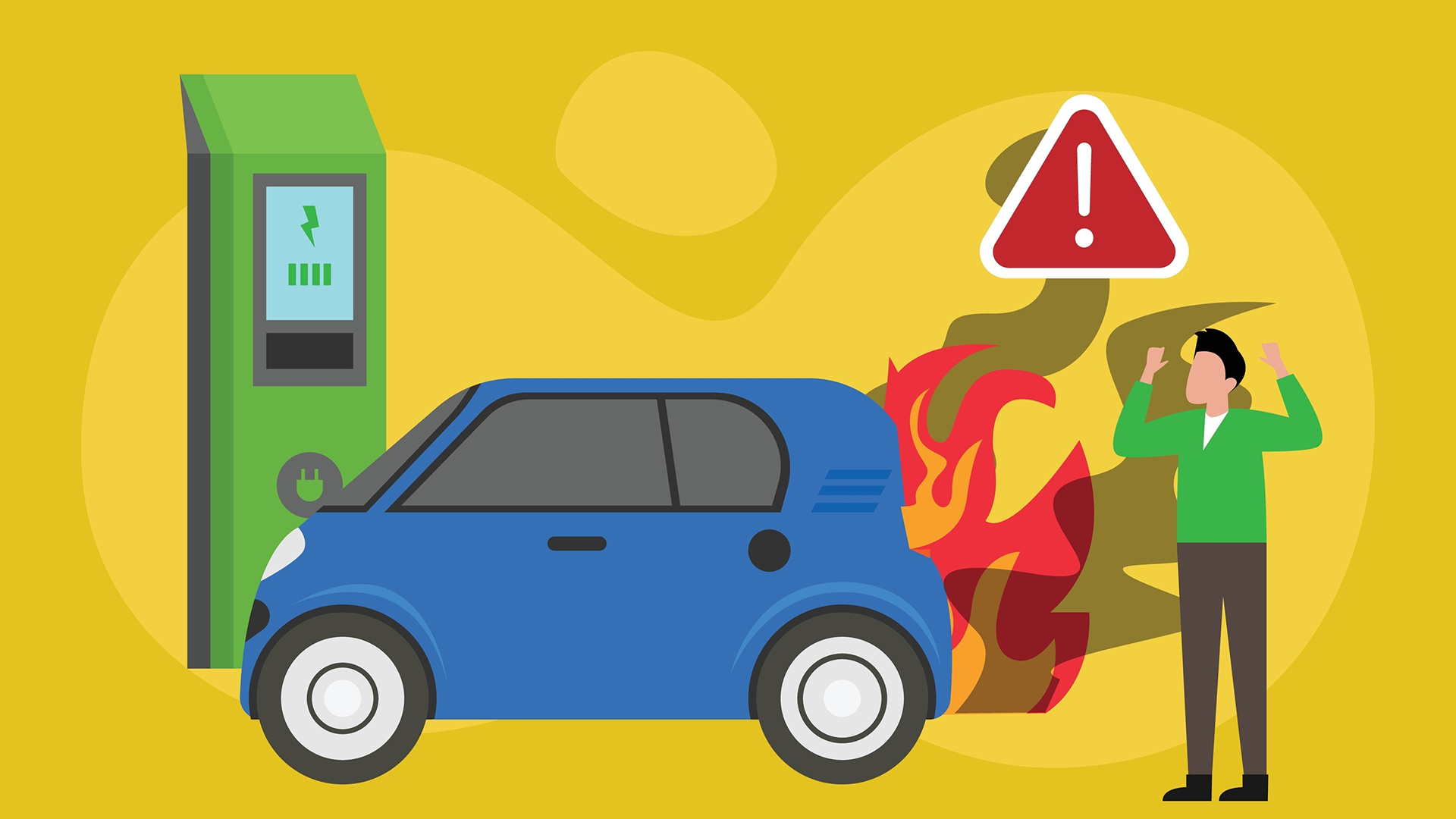Explore the risks and ongoing research into the causes of electric vehicle fires and discover advancements shaping a secure future for EVs through innovative technologies and safety protocols.
The increasing popularity of electric vehicles (EVs) has brought to the forefront various challenges related to their safety. One significant concern involves fires originating from these automobiles, a problem considerably different from its gasoline vehicle counterpart due to the unique components and operations of EVs. This issue demands attention due to the potential risks associated with such fires and the need for effective solutions.
This article will explore common causes of EV fires, considering how they compare in risk level to conventional gasoline vehicle fires. The impact of high-speed charging on fire risk, a key aspect of electric vehicle use, will also be examined.
Additionally, this discourse seeks to delve into specific challenges posed by electric vehicle fires and discuss current measures aimed at improving fire safety in EVs.
Finally, an overview will be given on ongoing research efforts dedicated towards enhancing the fire safety of electric vehicles.
What are the common causes of EV fires?
The common causes of electric vehicle fires include thermal runaway due to battery faults, short circuits, overcharging, and physical damage to the battery. Thermal runaway is a chain reaction whereby unstable batteries are unable to dissipate heat, meaning unchecked increases in temperature, often leading to a destructive result. This is a risk particularly associated with lithium-ion batteries used by most electric vehicles today.
Lithium-ion batteries are vulnerable to this process because they contain flammable electrolytes that can ignite if the battery becomes too hot. Short-circuits within these batteries can create a lot of heat, which might lead to thermal runaway as well.
Collision impacts also pose significant risks for electric vehicles due to potential damage they may cause to the lithium-ion batteries. An impact may compromise the structural integrity of the cells and could lead to internal short-circuiting and subsequently trigger a thermal runaway.

Moreover, faulty wiring or improper maintenance can exacerbate these issues by introducing more chances for electrical shorts or overheating problems.
These faults may be overlooked during routine maintenance checks but have potentially serious implications on vehicle safety and reliability, thereby increasing fire risk significantly.
What are the risks of EV fires compared to conventional gasoline vehicles?
While the perception of risk associated with battery-operated cars might be elevated due to media coverage, research indicates that traditional gasoline-fuelled automobiles are more likely to experience fires. EV fire statistics, however, should not be understated or ignored.
The inherent risks and challenges that come along with these kinds of fires require unique fire containment strategies and evacuation protocols. The main issue is centred on battery design flaws which can lead to thermal runaway.
The specific circumstances surrounding an electric vehicle’s combustion process pose different sorts of challenges for firefighters. For instance, an electric car fire can reignite even after being extinguished due to residual heat within the battery cells – a phenomenon essentially unheard of in typical gasoline car fires. This underlines the importance of specialised firefighter training programs tailored towards handling electric vehicle incidents effectively and safely.
While electric vehicles have their own distinct set of risks relating to fires, they are statistically still safer than their gasoline counterparts when comparing instances of vehicular combustion.
How does high-speed charging impact the fire risk of EVs?
The advent of high-speed charging technology for battery-operated cars has raised new questions about its potential influence on the likelihood of vehicular fires. High-speed or fast charging can potentially exacerbate battery degradation, especially if not properly managed through effective thermal management systems.
Furthermore, the infrastructure required to support high-speed charging needs to be robust and designed with safety measures in place to prevent overheating and other malfunctions that may lead to fires. Thus, while this technology offers substantial benefits in terms of reducing charging time and improving user convenience, it also introduces new challenges related to fire risk.
Advancements in material innovations and fire suppression techniques are crucial for mitigating these risks. Innovative materials with higher thermal stability can help reduce the chances of a battery overheating during fast charging.
Similarly, improved fire suppression techniques designed specifically for electric vehicles can quickly extinguish a fire if one does occur, minimising damage and potential harm. These advancements should be considered as integral components of the broader charging infrastructure development process.

What are the specific challenges posed by electric vehicle fires?
In a revealing study by AutoInsuranceEZ it was found that battery-related incidents accounted for less than 1% of all automotive fires. However, these incidents commanded significant attention due to their unique complexities and the difficulties inherent in extinguishing them.
The specific challenges posed by EV fires often arise from the high energy density of lithium-ion batteries used in most electric vehicles today. In some cases, thermal runaway – a chain reaction causing rapid increases in temperature – can occur, leading to the ignition of materials within the battery or adjacent to it. Battery management systems designed to prevent overheating can fail under certain circumstances, thus exacerbating fire risk.
EV fires also pose considerable challenges in terms of fire suppression and emergency response due to their distinct properties. Conventional methods of firefighting may be ineffective or potentially dangerous when dealing with lithium-ion battery fires because water can react with burning lithium metal, causing a hydrogen gas explosion. Therefore, specialist training is required for firefighters dealing with such scenarios.
Furthermore, established safety standards need continual updating as new information on electrical vehicle fire risks emerge from ongoing research and real-world incidents.
Lastly, post-fire investigation also tends to be more complex given that evidence can be destroyed or obscured by intense heat generated during a battery fire incident.
What steps are in place to improve the fire safety of EVs?
Manufacturers and researchers alike are investing considerable effort into enhancing the fire safety of battery-powered automobiles. Several aspects are focused on, including the development of advanced battery technologies designed to prevent thermal runaways. These runaways occur when a cell in a battery overheats, potentially causing a chain reaction leading to ignition.
Newer batteries are being developed with built-in safeguards such as thermal insulators or flame-retardant additives that can slow down or prevent this process, thus reducing the risk of fires.
In addition to advancements in battery technology, efforts are also concentrated on improving fire suppression systems specifically tailored for EVs. More effective systems not only extinguish flames but also cool the battery pack efficiently to stop any further thermal runaway events.
Furthermore, manufacturers and industry bodies continue to develop and implement stricter safety regulations for EV design and manufacturing processes.
Finally, an integral part of improving EV fire safety is enhanced firefighter training programmes which provide specialised knowledge on handling EV fires effectively.
What research is being done to improve the fire safety of electric vehicles?
Significant strides are being made in the realm of research to augment the fire safety measures associated with battery-powered automobiles. This research focuses primarily on four key areas:
Battery innovations
Researchers are focusing on developing advanced batteries that are not only energy-efficient but also less prone to overheating or causing fires. This includes exploring new chemistries and designs for batteries that can withstand high temperatures without triggering a thermal runaway reaction.
Safety regulations
Regulatory bodies worldwide are constantly revising and updating safety guidelines for EVs. Research efforts in this area aim at establishing stringent standards that ensure maximum protection against fire-related incidents in EVs.
Fire suppression techniques
Novel research is underway to devise effective fire suppression techniques specifically tailored for EVs. The uniqueness of EV fires necessitates specialised extinguishing agents and methods which could efficiently control and extinguish an electric vehicle blaze.
Thermal runaway prevention
One of the leading causes of EV fires is thermal runaway – a rapid uncontrolled increase in temperature leading to catastrophic failure or explosions in batteries. Significant research is dedicated to understanding this phenomenon better and creating strategies to prevent its occurrence.
Simultaneously, material advancements play an indispensable role in enhancing the fire resistance capabilities of electric vehicles’ components, including their battery systems.
By employing innovative materials with elevated heat tolerance levels and superior insulating properties, researchers aim at significantly reducing the risk posed by potential electrical malfunctions or short-circuits within the vehicle’s power system.
Mitigating EV fire risks
In conclusion, addressing EV fires has been no bed of roses. The complexities associated with the causes and high-speed charging impact bring new challenges to fire safety measures.
However, promising strides have been made in mitigating these risks through research and improved safety protocols.
Continued inquiry into the specificities of EV fires is crucial for the advancement of this technology. With concerted efforts from manufacturers, researchers, and policy makers alike, superior safety solutions will continue to emerge. This endeavour paints a hopeful future for electric vehicles.
Please note, this article will also appear in the sixteenth edition of our quarterly publication.









